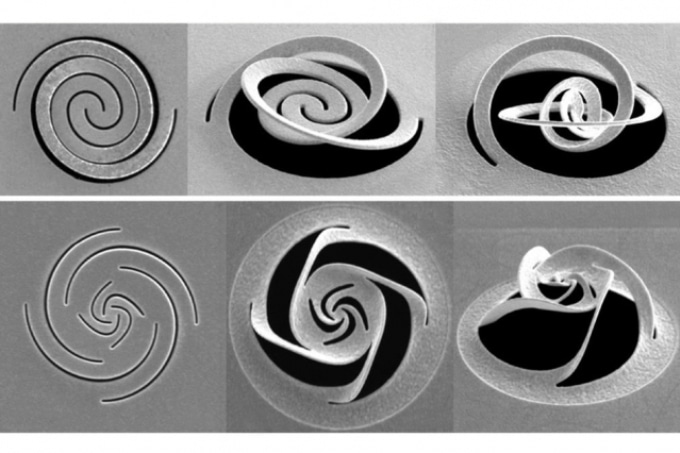Jul 9 2018
In the recent times, nanokirigami has started to emerge as an area of research; the technology is based on the ancient arts of origami, which involves making three-dimensional (3D) shapes by folding paper, and kirigami, which enables cutting and also folding, but used on flat nanoscale materials, measuring billionths of a meter.
 At left, different patterns of slices through a thin metal foil, are made by a focused ion beam. These patterns cause the metal to fold up into predetermined shapes, which can be used for such purposes as modifying a beam of light. (Image credit: Courtesy of the researchers)
At left, different patterns of slices through a thin metal foil, are made by a focused ion beam. These patterns cause the metal to fold up into predetermined shapes, which can be used for such purposes as modifying a beam of light. (Image credit: Courtesy of the researchers)
At present, for the first time, scientists from the MIT and in China have used this technology to develop nanodevices that could manipulate light, prospectively opening up innovative research possibilities and, eventually, the development of innovative light-based computational devices, detection, or communications.
The outcomes of the study have been reported in the Science Advances journal on July 6, 2018, in a paper published by Nicholas X Fang, MIT professor of mechanical engineering, and five of his colleagues. Fang and his team used techniques based on standard microchip manufacturing technology, in order to apply a focused ion beam to form a precise slit pattern in a metal foil with a thickness of only a few tens of nanometers. The procedure makes the foil bend and twist on its own into a complex 3D shape with the ability to selectively filter out light with a specific polarization.
According to Fang, in earlier efforts toward developing functional kirigami devices, highly complicated fabrication techniques that mandate a sequence of folding steps and have been mainly aimed at mechanical and not optical functions were used. The new nanodevices, by contrast, can be formed in a single folding step and could be used to perform a number of different optical functions.
For these initial proof-of-concept devices, the researchers developed a nanomechanical equivalent of specialized dichroic filters with the ability to filter out circularly polarized light that is “right-handed” or “left-handed.” In order to achieve this, they formed a pattern with a size of just a few hundred nanometers in the thin metal foil; the result looks like pinwheel blades, with a twist in one direction that selects the corresponding twist of light.
The foil twists and bends due to stresses brought about by the same ion beam that slices through the metal. When ion beams with low dosages are used, several vacancies are formed, and certain ions get lodged in the crystal lattice of the metal, driving the lattice out of shape and developing strong stresses that produce the bending.
“We cut the material with an ion beam instead of scissors, by writing the focused ion beam across this metal sheet with a prescribed pattern,” stated Fang. “So you end up with this metal ribbon that is wrinkling up” in the precisely planned pattern.
It’s a very nice connection of the two fields, mechanics and optics.
Nicholas X Fang, MIT professor of mechanical engineering.
Fang said that to split up the clockwise and counterclockwise polarized portions of a light beam, which may depict “a brand new direction” for nanokirigami studies, they used helical patterns.
The methodology is direct enough that, with the equations developed by the researchers, scientists should now be in a position to calculate backward from a desired set of optical properties and generate the required slit and fold pattern and to produce just that effect, stated Fang.
“It allows a prediction based on optical functionalities” to form patterns that accomplish the desired result, he added. “Previously, people were always trying to cut by intuition” to form kirigami patterns for a specific desired result.
Fang specified that the study is only in its early stage; hence, more studies will be required on probable applications. However, these devices are several orders of magnitude smaller when compared to traditional equivalents that carry out the same optical functions; hence, these developments could result in highly complex optical chips for computation, sensing or communications systems, or biomedical devices, the researchers stated.
For instance, Fang stated that devices used for measuring glucose levels, in general, use measurements of light polarity since glucose molecules occur in right- and left-handed forms which interact with light in distinctive ways. “When you pass light through the solution, you can see the concentration of one version of the molecule, as opposed to the mixture of both,” explained Fang, and this technique could enable the development of considerably smaller and highly efficient detectors.
Circular polarization is also a technique adopted to enable multiple laser beams to pass through a fiber-optic cable without interfering with one another. “People have been looking for such a system for laser optical communications systems” to isolate the beams in devices known as optical isolaters, stated Fang. “We have shown that it’s possible to make them in nanometer sizes.”
The team also included MIT graduate student Huifeng Du; Zhiguang Liu, Jiafang Li (project supervisor), and Ling Lu from the Chinese Academy of Sciences in Beijing; and Zhi-Yuan Li from the South China University of Technology. The National Key R&D Program of China, the National Natural Science Foundation of China, and the U.S Air Force Office of Scientific Research supported the study.